External counterpulsation
| External counterpulsation | |
|---|---|
 Illustration showing cardiac external counterpulsation | |
| Synonyms | Enhanced external counterpulsation (EECP) |
External counterpulsation therapy (ECP) is a procedure that may be performed on individuals with angina, heart failure, or cardiomyopathy.
Medical uses
Some reviews did not find sufficient evidence that it was useful for either angina or heart failure.[1][2] Other reviews found tentative benefit in those with angina that does not improve with medications.[3][4]
For stroke due to lack of blood flow a 2012 Cochrane review found insufficient evidence to make conclusions.[5]
Method
While an individual is undergoing ECP, he/she has pneumatic cuffs on his or her legs and is connected to telemetry monitors that monitor heart rate and rhythm. The most common type in use involves three cuffs placed on each leg (on the calves, the lower thighs, and the upper thighs (or buttock)). The cuffs are timed to inflate and deflate based on the individual's electrocardiogram. The cuffs should ideally inflate at the beginning of diastole and deflate at the beginning of systole. During the inflation portion of the cycle, the calf cuffs inflate first, then the lower thigh cuffs and finally the upper thigh cuffs. Inflation is controlled by a pressure monitor, and the cuffs are inflated to about 200 mmHg.
Physiological considerations
One theory is that ECP exposes the coronary circulation to increased shear stress, and that this results in the production of a cascade of growth factors that result in angiogenesis.[6]
References
- ↑ McKenna, C; McDaid, C; Suekarran, S; Hawkins, N; Claxton, K; Light, K; Chester, M; Cleland, J; Woolacott, N; Sculpher, M (April 2009). "Enhanced external counterpulsation for the treatment of stable angina and heart failure: a systematic review and economic analysis". Health technology assessment (Winchester, England). 13 (24): iii–iv, ix–xi, 1–90. doi:10.3310/hta13240. PMID 19409154.
- ↑ Amin, F; Al Hajeri, A; Civelek, B; Fedorowicz, Z; Manzer, BM (17 February 2010). "Enhanced external counterpulsation for chronic angina pectoris". The Cochrane Database of Systematic Reviews (2): CD007219. doi:10.1002/14651858.CD007219.pub2. PMID 20166092.
- ↑ Soran, O (August 2014). "Alternative therapy for medically refractory angina: enhanced external counterpulsation and transmyocardial laser revascularization". Cardiology clinics. 32 (3): 429–38. doi:10.1016/j.ccl.2014.04.009. PMID 25091968.
- ↑ Qin, X; Deng, Y; Wu, D; Yu, L; Huang, R (2016). "Does Enhanced External Counterpulsation (EECP) Significantly Affect Myocardial Perfusion?: A Systematic Review & Meta-Analysis". PLoS ONE. 11 (4): e0151822. doi:10.1371/journal.pone.0151822. PMC 4821484. PMID 27045935.
- ↑ Lin, S; Liu, M; Wu, B; Hao, Z; Yang, J; Tao, W (18 January 2012). "External counterpulsation for acute ischaemic stroke". The Cochrane Database of Systematic Reviews. 1: CD009264. doi:10.1002/14651858.CD009264.pub2. PMID 22259001.
- ↑ Soran O, Crawford LE, Schneider VM, Feldman AM (March 1999). "Enhanced external counterpulsation in the management of patients with cardiovascular disease". Clin Cardiol. 22 (3): 173–8. doi:10.1002/clc.4960220304. PMID 10084058.
Manchanda A, Soran O (October 2007). "Enhanced external counterpulsation and future directions: step beyond medical management for patients with angina and heart failure". J. Am. Coll. Cardiol. 50 (16): 1523–31. doi:10.1016/j.jacc.2007.07.024. PMID 17936150.